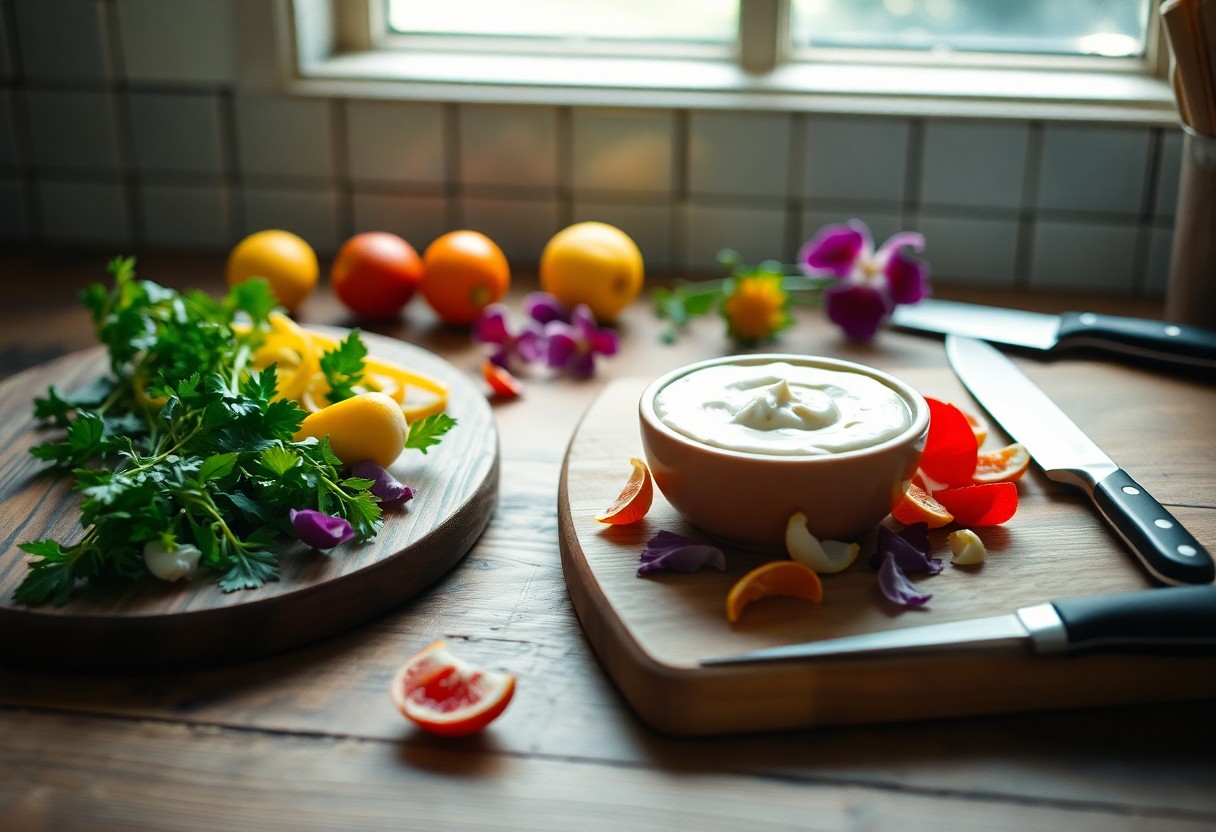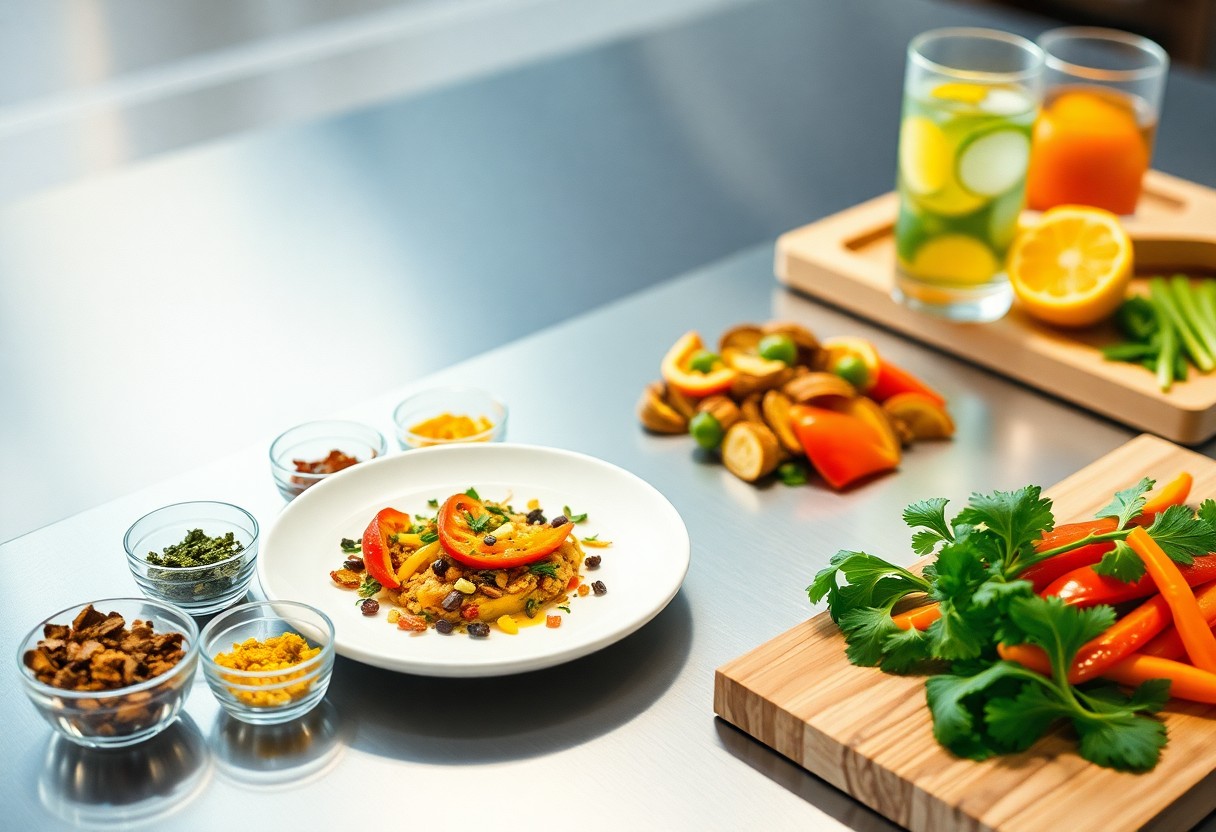There’s an incredible opportunity lurking in your refrigerator: leftover garnishes. Instead of tossing them away, you can creatively transform them into the foundation of a delicious new dish. By using items like herb sprigs, citrus peels, or onion tops, you can enhance your culinary repertoire while minimizing food waste. In this guide, you’ll discover practical ways to repurpose these often-overlooked ingredients, ensuring that every flavor contributes to a satisfying meal. Get ready to elevate your cooking and make the most of what you have on hand.
Key Takeaways:
- Get creative by incorporating leftover garnishes into new dishes, transforming them into flavorful bases for soups, salads, or stir-fries.
- Experiment with different flavor profiles by combining various garnishes, enhancing the overall taste and presentation of your new creation.
- Utilize garnishes that have different textures and colors to add visual appeal and interest, elevating the dish beyond just a simple use of leftovers.
Transformative Recipes: Elevating Garnishes to Stand-Alone Dishes
Repurposing your leftover garnishes into hearty, satisfying meals not only minimizes waste but also sparks creativity in your kitchen. From vibrant herb-based dishes to zesty sauces that lift your meals, these transformative recipes will elevate your garnishes to new heights, turning what once was an afterthought into a culinary star.
Utilizing Herb and Leafy Green Leftovers
Instead of tossing those wilted herbs or leftover leafy greens, harness their potential to create delightful salads, pestos, or soups. A blend of leftover spinach, basil, or parsley can form a nutrient-dense green smoothie, enhancing both flavor and health benefits. Pair them with nuts and cheese for a refreshing salad that surprises with every bite.
Making Flavor-Packed Sauces from Leftover Accents
Leftover garnishes can blossom into vibrant sauces that redefine your dishes. Chimichurri, made from extra parsley and garlic, transforms grilled meats, while an aioli can incorporate leftover herbs for a robust flavor boost. These sauces not only enhance your meals but also keep your creativity flowing and your palate excited.
Turn your kitchen scraps into delicious condiments by combining leftover garnishes such as chives, cilantro, or even citrus peels. For instance, blending leftover herbs with olive oil, vinegar, and spices can yield a tangy sauce that complements everything from roasted vegetables to pasta. Don’t shy away from experimentation; mixing in leftovers with unexpected flavors can lead to delightful surprises. A squeeze of citrus or a touch of honey can transform a simple mix into a standout sauce, making your creations unique and memorable while minimizing waste.
Culinary Alchemy: Reinventing Last Night’s Additions
Transforming leftover garnishes into delightful new creations showcases your culinary skills. By tapping into their untapped potential, you not only create delicious food but also reduce waste. Embracing this culinary alchemy allows you to play with flavors and textures, turning yesterday’s embellishments into today’s main attractions. From tiny sprigs of herbs to zesty condiments, the possibilities are as diverse as your imagination.
Turning Pickles and Relishes into Savory Salads
Pickles and relishes often hold concentrated flavors that can elevate a simple salad. You can chop pickles finely and mix them into a salad base of greens, adding a satisfying crunch while creating a zesty dressing with the brine. Combine these tangy elements with ingredients like nuts, cheese, or quinoa for a nutritious dish that bursts with flavor and texture.
Crafting Unique Soups Using Extra Garnishments
Your leftover garnishes can transform a basic broth into a vibrant soup. For example, if you have leftover herbs or fried onions, toss them into simmering broth alongside any minced vegetables or remnants from your fridge. Blend it all until smooth, or leave it chunky, depending on your preference. This technique not only amplifies the soup’s flavor but also adds nutritional value, allowing you to take full advantage of every ingredient on hand.
To elevate your soup even further, think about incorporating diverse garnishes like roasted garlic, chili flakes, or a dollop of leftover yogurt or sour cream. Each of these additions can dramatically change the soup’s character, providing depth and richness while minimizing waste. Experiment with different combinations to discover bold new flavors—turning yesterday’s leftovers into today’s delectable meal.

Smart Pairings: The Art of Combining Flavors
Crafting new dishes from leftover garnishes is all about understanding the synergy of flavors. By exploring combinations that enhance one another, you create a harmonious dining experience. For instance, if you have leftover cilantro from a salsa, pairing it with citrus fruits like orange or lime can elevate your new dish, making it vibrant and fresh. Consider experimenting with herbs, spices, and acidity to discover unique flavor profiles that surprise and delight your palate.
Complementary Ingredients: Building Flavor Profiles
Think about the basic flavors—sweet, sour, salty, bitter, and umami. Combining ingredients with complementary tastes can create a dynamic flavor profile. For instance, if you have leftover roasted tomatoes, incorporating Feta cheese can introduce a creamy, salty element that beautifully contrasts with the sweetness of the tomatoes, resulting in a well-rounded dish.
Balancing Textures: Achieving Culinary Harmony
Incorporating various textures enhances the overall experience of your meal. A mix of crunchy, creamy, and chewy elements keeps your palate engaged and satisfied. For example, adding crispy sautéed kale to a creamy risotto not only contrasts textures but also boosts nutritional value.
Texture plays a significant role in how you perceive a dish. Crunchy toppings, like toasted nuts or crispy herbs, provide a satisfying contrast to smooth or creamy bases, such as pureed soups or pasta sauces. The interplay creates a delightful sensation. Experiment by layering textures, such as a crunchy salad topping over a tender grain bowl. The goal is to achieve a balance that keeps each bite exciting and enjoyable. By paying attention to textural variations, you transform simple leftovers into gourmet creations that delight your senses.
Waste Not, Want Not: The Environmental Impact
Reducing food waste directly supports a more sustainable environment, as approximately 30-40% of the food supply in the United States is wasted. This waste contributes to rising greenhouse gas emissions, as discarded food decomposes in landfills. By utilizing leftover garnishes as a foundation for new dishes, you actively participate in minimizing that waste, making choices that favor our planet’s health and reducing your carbon footprint.
Sustainable Cooking Practices for Home Chefs
Adopting sustainable cooking practices benefits both your kitchen and the environment. Incorporating techniques such as composting, meal planning, and creative repurposing of ingredients will not only enhance your culinary skills but also underscore your commitment to sustainability. Every time you use leftover garnishes, you contribute to a more eco-friendly kitchen, and your meals become both delicious and sustainable.
The Cost-Efficiency of Utilizing Leftovers
Using leftovers can significantly lower your grocery bills while maximizing the flavors in your dishes. By transforming leftover garnishes into new meals, you extend the life of your ingredients and make the most of your culinary investments.
For instance, consider a situation where you have leftover herbs and vegetables from previous meals. Instead of discarding them, you can create a vibrant pesto or a savory vegetable soup, saving you from unnecessary expenses on fresh ingredients. According to the USDA, the average family of four discards around $1,500 worth of food annually. By prioritizing leftovers, you can redirect that wasted potential straight into not just your stomach, but also your savings, all while enjoying a delicious array of meals.

Innovative Presentation: Serving Up Leftover Creativity
Transforming leftover garnishes into new dishes is not just about enhancing flavor but also about showcasing your culinary creativity. By leveraging the right plating techniques, you elevate the aesthetic appeal of your presentations, making even the simplest ingredients look gourmet. Use vibrant colors and interesting textures to your advantage, creating dishes that are both delectable and visually enticing.
Plating Techniques that Impress
Elevate your dishes with plating techniques that catch the eye and spark conversation. For instance, use negative space on the plate to highlight your main ingredient surrounded by a colorful drizzle of sauce or strategically placed garnishes. Techniques like stacking, layering, or using unusual vessels can draw attention and create a memorable dining experience.
Garnishing with Purpose: Enhancing Appeal
Each garnish should not just serve as decoration but also enhance the flavor profile of the dish. Fresh herbs, edible flowers, or zesty citrus can bring brightness, while crunchy textures or contrasting colors can add depth. By selecting garnishes that complement your dish’s ingredients, you’re ensuring that every element works in harmony for an unforgettable meal.
For example, a simple pasta dish might benefit from a sprinkle of microgreens or toasted pine nuts, which not only enhance visual appeal but also offer a pop of flavor and texture. Similarly, if you’re using leftover citrus peels, zest them finely and scatter them over your dish to provide a burst of freshness. Think about how each garnish can create a dialogue with the main ingredients, transforming your dish into a cohesive and delightful culinary experience.
Final Words
So, when you find yourself with leftover garnishes, consider them a versatile foundation for your next culinary creation. You can transform those remnants into flavorful soups, vibrant salads, or enriching sauces, maximizing their potential and reducing waste. By infusing your base dishes with these ingredients, you elevate your meals while adding creativity to your cooking routine. Embrace this sustainable approach and watch as your kitchen becomes a more inspiring space, encouraging you to explore new flavors and textures with every dish you create.
FAQ
Q: What types of leftover garnishes can I use as a base for a new dish?
A: You can utilize a variety of leftover garnishes such as fresh herbs (like parsley, cilantro, or basil), citrus zests, chopped nuts, or even unused sauces and dressings. For example, leftover herb sprigs can be blended into a pesto or salad. Citrus zests can enhance sauces or marinades, while chopped nuts can add a lovely texture to grain bowls or baked dishes. The key is to get creative and think about how these flavors can complement new ingredients.
Q: How can I incorporate leftover garnishes into different types of cuisines?
A: Leftover garnishes can be surprisingly versatile across various cuisines. For instance, if you have leftover cilantro and lime, you might consider making a Mexican-inspired dish by tossing them with black beans and avocado. Fresh herbs like basil can be transformed into a vibrant Italian sauce, while leftover sesame seeds can add depth to a stir-fry or Japanese-inspired dish. Explore pairing your garnishes with grains, proteins, or vegetables from different cultural backgrounds, allowing you to create unique flavors.
Q: What are some creative dish ideas using leftover garnishes?
A: Various creative dishes can spring from your leftover garnishes. For instance, leftover sautéed onions and herbs can be combined with eggs to make a delicious frittata. You can also create a refreshing grain salad by adding leftover chopped greens and nuts, mixing with cooked quinoa or rice, and drizzling with olive oil and lemon juice. Another option is to blend unused sauces with additional ingredients to make a flavorful dip or dressing, enriching a charcuterie board or salad. The possibilities are endless; just experiment with what you have on hand!
